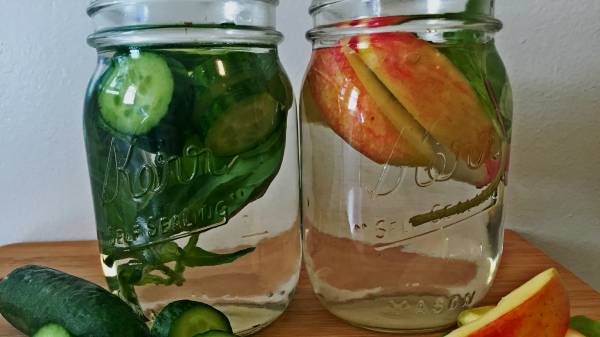I sweat the minute I begin to move, so my hydration needs to be on-point from the start to the end of my workout. Otherwise, my body becomes a cramping machine all day long. Unfortunately, staying hydrated presents two challenges for myself and many others:
- I have concerns about the safety of our water supply.
- I don’t like the taste of water.
For these reasons, I have to take conscious steps to get the amount I need each day. Here’s how I’ve overcome these obstacles and learned to trust and love good old H20.
Proper hydration will fuel your performance for the long haul.
A Wake Up Call: The Flint Water Crisis
Water contamination is a huge concern, especially for athletes, who have a higher need for adequate hydration. Even without having cable or watching the news, it is hard not to be aware of the water crisis in Flint, Michigan. Contaminated water was being sent into homes, causing major community health risks such as high lead levels that caused triple-digit increases in children. This news, coupled with the realization that those in charge may have known about the problem, is beyond belief.
This situation was a huge wake up call for me. I realized I needed to educate myself to understand how water gets into my home and how I can keep my drinking water as safe as possible. Here are a few key points I gleaned from my research:
- Although water treatment plants are tested and treated by the Environment Protection Agency (EPA) for some harmful contaminants, this does not include all contaminants. The testing only focuses on those contaminants that have known health risks.
- In the United States we have the Safe Drinking Water Act (SDWA) that originated in 1974 and was amended as late as 1996. This act was put in place to regulate and protect public drinking water from natural and man-made contaminants that often invade our water supply, such as pesticides, fecal matter, chemical waste, animal waste, and naturally occurring contaminants.
- One of the key amendments to the SDWA in 1996 was based around the public’s demand to know what was in the water they drank. As a result, all community water systems are required to prepare and supply safety reports for the public. This report is to be supplied yearly by the water companies and made available directly to the consumer. The current amended law also requires the water company to notify the public within 24 hours of becoming aware of contamination. If this does not happen, criminal charges can result.
In Flint, homicide charges are pending if not already filed. Sadly, once again we are learning these laws often fall on deaf ears, and public health takes a back seat.
Healthy Water at Home
Fortunately, staying safe only requires a few easy steps. Lets start with your house. Some type of filtration is your best defense and most cost effective. There are several ways you can do this:
- Use a Carafe: A simple filtered pitcher carafe like a Brita is a great start. These remove lead and chlorine, but do not remove pesticides, bacteria, and chemicals.
- Install a Faucet Filter Tap: Another cost-effective step similar to the carafe filter is a tap filter. These fit directly onto your faucet and offer a better contamination control than your carafe filter and often are actually more cost effective. The cost of a replacement for a carafe is higher than a tap filter.
- Use Reverse Osmosis: Reverse osmosis systems provide protection against a wide range of contaminants, from bacteria to pesticides and even fluoride. These systems have a higher start up and installation cost, but overall are very economical.
Not in the budget? That’s okay. Here are some simple low- to no-cost tips:
- Boil water before drinking.
- Run your tap a few minutes before using the water.
- Drink from the cold tap only.
The Power of Infusion
As I’ve become more aware of water safety, I’ve continued to come up with creative ways to make my water taste better. One of the first steps I took in that direction was beginning to infuse my water with fresh herbs and fruit. Not only does it make water much more drinkable, but it also looks beautiful in my BPA-free, glass water vessels. When I am in public with infused water, you can bet someone will stop to ask about it.
If you find yourself falling short on hydration, try some of these the next time you are working up a good old-fashioned sweat.
Refreshing Herb and Fruit Infused Water

Yield: Single Serving
Prep time: 5 minutes
Flavor Combinations:
- Cucumber and fresh basil
- Apple and fresh mint
Method:
- Combine a handful of each herb and three slices minimum of veggie or fruit into a BPA-free container.
- Add water and enjoy!
Note:
- You can continue to add water for 24 hours without a need to replace the fruit and herbs.
Have fun and experiment with your hydration infusions!
More Help With Hydration:
- 10 Life-Changing Reasons to Drink More Water
- An Athlete’s Guide to Hydration: When, What, and How Much
- How Long Does It Take to Get Hydrated?
- New on Pulse Beat Fit Right Now
References
1. “Drinking Water Quality: What You Need to Know.” WebMD, accessed February 15, 2016.
2. “3 Ways to Make Your Drinking Water Safer.” Ask Dr. Sears, accessed February 15, 2016.
3. “5 Things to Know About Flint’s Water Crisis.” CNN, accessed February 15, 2016.
4. “Understanding the Safe Drinking Water Act.” EPA, accessed February 15, 2016.
Photo 1 courtesy of Shutterstock.
Photo 2 courtesy of V. Capaldi.






